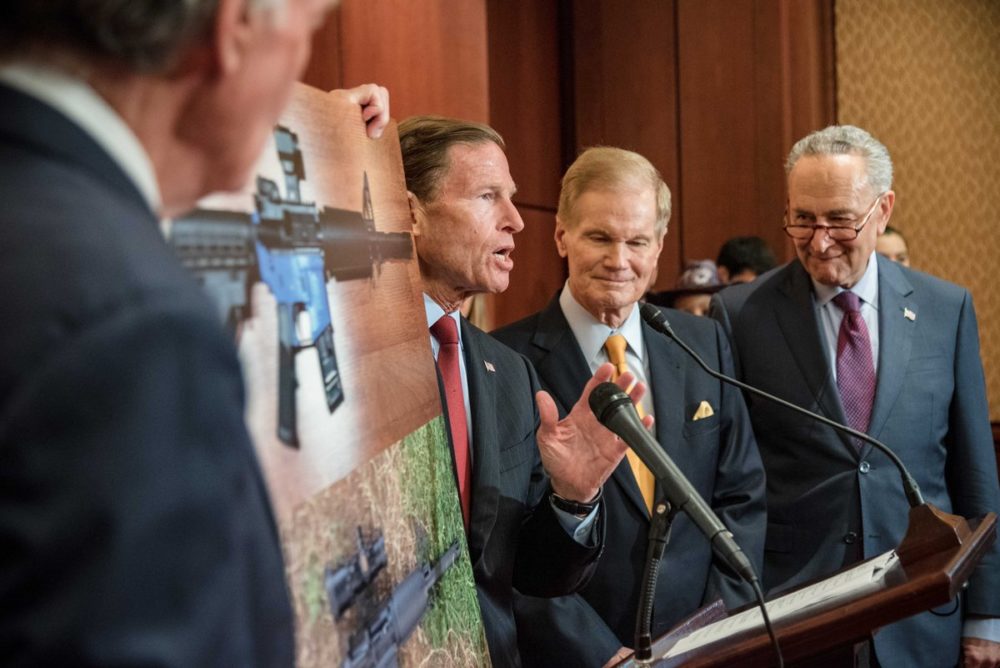
A number of Senate Democrats to include Bill Nelson of Florida, Chuck Schumer of New York and Richard Blumenthal of Connecticut decry the availability of 3D printed gun plans at a press conference on Tuesday (Photo: Blumenthal’s office)
The brawl over downloadable gun manufacturing code reached Capitol Hill on Tuesday with a group of Democrats in both chambers vowing action.
No less than a trio of new bills dealing with regulations on 3D printed gun files and the firearms they could produce were highlighted in Washington this week. The legislation included the 3D Printed Gun Safety Act crafted by U.S. Sen. Bill Nelson, D-Fla; and a pair of bills updating the 1988-era Undetectable Firearms Act debuted by Connecticut’s Richard Blumenthal in the Senate and U.S. Rep. David Cicilline in the House.
“These 3D-printed plastic firearms can evade our detection systems and are a direct threat to our national security,” said Nelson, holding the guns could be coming to schools, airports and other sensitive areas despite the use of x-ray machines and screeners at security checkpoints.
The original Undetectable Firearms Act, requiring at least 3.7-ounces of steel in a firearm made or otherwise imported into the country, came about in an era of misinformation about “plastic” or “porcelain” guns. Driven by such Hollywood portrayals as the fictional Glock 7 seen in Die Hard 2 and a composite pistol used in an assassination attempt depicted by actor John Malkovich in a Clint Eastwood movie, the UFA was twice reauthorized and is set to continue in its current form until 2023.

Cody Wilson’s Liberator, seen here in an x-ray, details that a small block of steel should be mounted in a hole in front of the trigger guard to comply with current law (Photo: DefDist)
The lawmakers behind the proposals this week seek to block the publication of the blueprints that can be used to make 3D-printed guns while arguing the current law on undetectable firearms should be modernized to mandate which primary components of a firearm should be metal.
One of the guns at the heart of the debate on printed firearm designs — Cody Wilson’s Liberator marketed by Defense Distributed first in 2013 — details that a 1.19×1.19×0.99-inch block of steel should be permanently epoxied into a purpose-designed cavity in front of the trigger guard to comply with the law. Nelson and his fellow Democrats hold that such “detachable metal clips can often be easily removed before entering a security screening area and reattached again after to meet the law’s requirement.”
Cicilline’s proposed bill also includes adding a definition to federal law for the term “ghost gun” and outlawing possession of one after 2020. The definition would encompass any firearm that lacks a unique serial number. Bills similar to the ones proposed were introduced to Congress last year but have been stuck in committee.
Reaction
Elsewhere in Washington, President Donald Trump tweeted that he was “looking into 3-D Plastic Guns being sold to the public,” going on to say that he had spoken with the National Rifle Association on the matter and the issue, “doesn’t seem to make much sense.”
The White House later expanded on that, with deputy press secretary Hogan Gidley telling reporters,”In the United States, it’s currently illegal to own or make a wholly plastic gun of any kind, including those made on a 3D printer.”
The controversy left national gun rights groups with varying degrees of reaction, with the National Rifle Association issuing a guarded statement on Tuesday saying that “anti-gun politicians and members of the media have wrongly claimed that 3-D printing technology will allow for the production and widespread proliferation of undetectable plastic firearms,” going on to point to the 30-year-old regulation on undetectable firearms. Meanwhile, Gun Owners of America took a more vehement stand that forecasts of printed guns in the hands of criminals are a red herring to block the spread of constitutionally-protected information.
“This is freedom. This is what the Second Amendment protects,” said Erich Pratt, GOA’s executive director. “With few exceptions under federal law, it is legal to make your own personal firearm, as long as it is not transferred to another person. Why wouldn’t the Second Amendment protect the right of a law-abiding citizen to make his or her own weapons?”
Late Tuesday, a federal court in Seattle granted a temporary order blocking DefDist from their planned release of 3D gun data, much of it already in the public domain, but Nelson argued the drive to pass more regulation is now.
The post Dems file at least 3 bills in Congress to block 3D printed guns appeared first on Guns.com.
